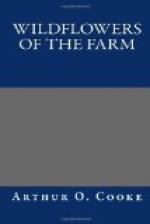We must not stroll all over this field as we did in Ashmead, for the long grass should not be trampled down, or it will be difficult for the machine to cut. Quite near the gate, however, are plenty of flowers, and we shall find others if we step carefully along the side of the hedge.
We will look first at those flowers which are most important to the farmer, the flowers of the grass. We saw, you remember, that the grass has flowers just as the Rose and the Wallflower have. If you had thought that the flowers of all grass would be alike, you see now that you were quite mistaken; there are many different grass flowers here.
[Illustration: SECTION OF GRASS STEM.]
Not only are the flowers different, but so are the stems, and also the leaves or blades. Mr. Hammond could come into the field in early spring or autumn, when the grass is not in flower, and could tell you to which kind of grass any blade belonged. To-day we shall easily distinguish the different kinds of grasses by their flowers, though we will also notice differences in their stems and leaves.
Let us pick a stem or culm of grass. We see that the greater part of it is hollow; but at intervals there are joints, and here the stem is solid. From each joint grows a leaf-sheath which is wrapped round the stem for a little distance above the joint. Out of each sheath grows a leaf. All grass leaves are long and narrow compared with those of most other plants, but some grass leaves are longer and narrower than others.
Now for a flower. The stem which we have picked is the stem of perennial Rye Grass. The blossom, we see, consists of several small spikelets; there are eighteen on our stem. They grow alternately on two opposite sides of the stem, first one on one side, then one on the other. They have no stalk of their own; they are sessile or seated on the stem. As the spikelets are flat and grow on two sides of the stem only, each stem looks as if it had been pressed in a book, as perhaps you have sometimes pressed flowers.
The leaves are dark green, glossy and shining. On the under side of each leaf there is a prominent rib which extends the whole length. This rib is one of the signs by which Mr. Hammond can tell a blade of Rye Grass at once without seeing the flower.
This is one of the farmer’s most useful grasses. It forms a close thick carpet or sward, and, the more it is trodden on by animals grazing, the better it seems to thrive.
Here is another excellent grass, with a flower quite different in appearance from the last. It is called Timothy Grass. It was first cultivated in America by a man named Timothy Hanson, and it is now always known by his Christian name. Mr. Hammond knows this, and now you know it too; but a good many farmers who have plenty of Timothy Grass in their fields do not know the reason of its name.
[Illustration: COWSLIP.]
[Illustration: HONEYSUCKLE AND WILD ROSE.]




